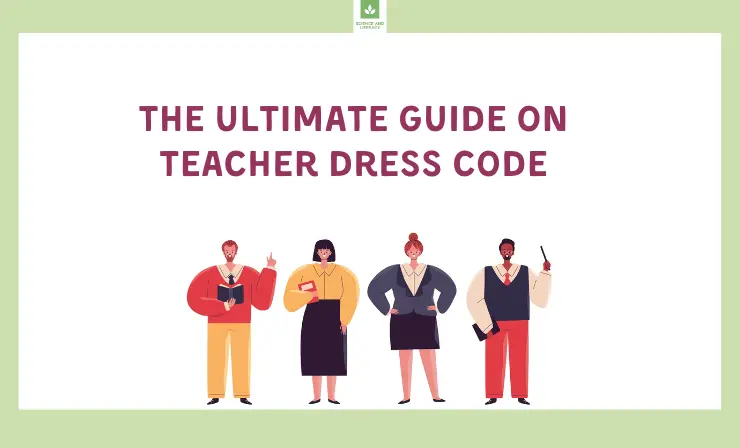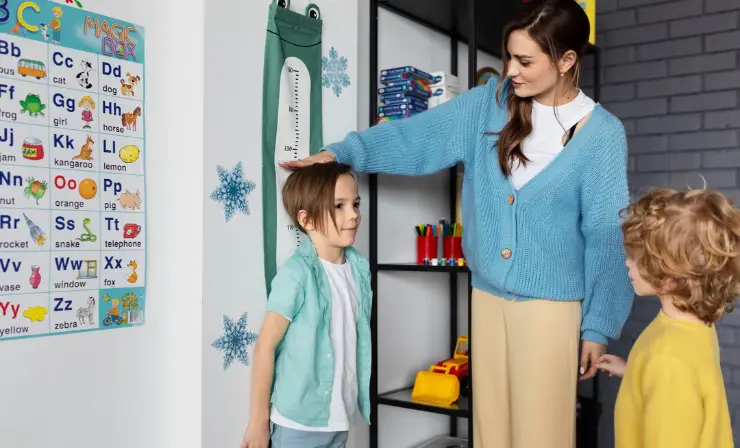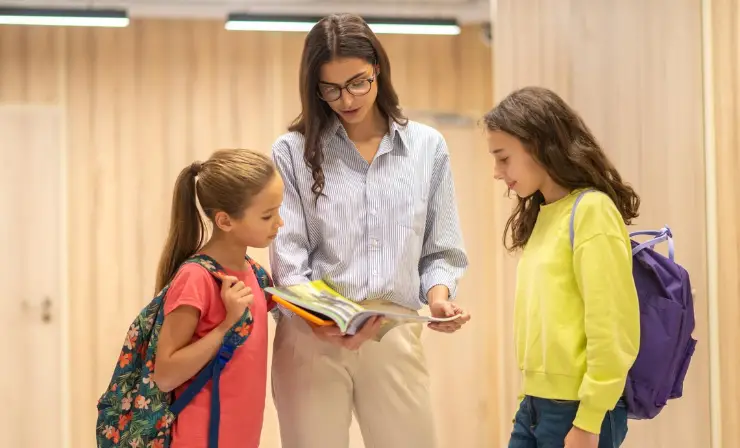In the world of education, where professionalism and role modeling are paramount, the issue of teacher dress code holds significant importance. A teacher’s attire not only influences their own self-confidence but also sets an example for students. Different schools, ranging from preschools to high schools and colleges, often have specific guidelines for their teacher dress code, reflecting their unique values, priorities, and educational philosophies. These dress codes have a rich history, and in this comprehensive guide, we’ll delve into the fascinating journey of teacher attire across different types of educational institutions.

From the nurturing environments of preschools to the diverse and innovative world of college classrooms, we’ll explore the dos and don’ts, the underlying rationale behind these policies, and the subtle ways dress codes adapt to the ever-changing landscape of education. The history of teacher dress codes is intertwined with the evolution of educational ideals and societal norms, revealing how attire has been used to convey professionalism, discipline, and connection to the learning environment.
In recent decades, the concept of teacher dress codes has become more nuanced, reflecting the diverse values and philosophies of each educational institution. While some schools still uphold traditional dress codes, others encourage teachers to express their individuality within the bounds of professionalism, recognizing that a teacher’s personal style can foster a more relatable and inclusive environment.
Whether you’re a student teacher, a seasoned educator, or just curious about the topic, join us as we navigate the intricacies of teacher dress codes. In this comprehensive guide, we’ll explore the various aspects of teacher dress codes across different types of schools, shedding light on the dos and don’ts, as well as the underlying rationale behind these policies.
Dress code for teachers is advisable just like uniforms for kids.
— Silver Light (@tvgts8g4z4) August 13, 2023
After reading this article, you’ll get to know about:
- Preschool Teacher Dress Code→
- Elementary School Teacher Dress Code→
- Understanding CCSD Teacher Dress Code→
- College Teacher Dress Code→
- Liberal Arts and Creative Disciplines→
- Innovation and Hybrid Learning→
- Graduate and Research Institutions→
- Navigating the Female Teacher Dress Code→
- Dress Code Variations and School Culture→
- Adapting to Seasonal Changes: Dressing Comfortably and Professionally→
- Online and Hybrid Teaching Environments→
- Conclusion →
Preschool Teacher Dress Code

For Male: Preschool teachers are expected to wear casual yet neat clothing. Comfortable slacks or trousers are a common choice, often paired with modest polo shirts or blouses. Closed-toe shoes are essential for footwear. Bright and vibrant colors, reflecting the preschool atmosphere, are encouraged.
For Female: Female preschool teachers can opt for comfortable and modest attire, such as skirts, dresses, or slacks, paired with appropriate blouses. The dress code allows for bright and child-friendly patterns, contributing to a cheerful ambiance. Closed-toe shoes are the preferred footwear choice.
Colors of Dress Code: Vibrant and cheerful colors are encouraged, mirroring the lively preschool setting.
Style of Hair: Hairstyles should be professional and manageable, considering the active nature of working with young children.
For example, at Sunny Days Preschool, the dress code encourages teachers to wear comfortable yet professional attire. Bright and cheerful colors, along with child-friendly patterns, create an approachable atmosphere while maintaining a polished appearance.
Elementary School Teacher Dress Code

For Male: Elementary school teachers are expected to dress in a business casual manner. Slacks or trousers with well-fitted shirts or blouses in neutral colors and classic patterns are common. Comfortable yet suitable footwear is essential.
For Female: Female elementary school teachers often wear business casual attire, including slacks, skirts, or dresses paired with appropriate blouses. The dress code emphasizes neutral colors and classic patterns, projecting a polished and approachable appearance. Comfortable footwear is essential.
Colors of Dress Code: Neutral colors and classic patterns are preferred, creating a polished and professional image.
Style of Hair: Hairstyles should be professional and well-groomed, reflecting the teacher’s commitment to setting a positive example for young students.
At Central Elementary School, the dress code emphasizes a professional and approachable appearance. Neutral colors, earth tones, and subtle patterns reflect the school’s focus on learning, maintaining a respectful atmosphere.
Middle School Teacher Dress Code

For Male: Middle school teachers often opt for smart casual attire. Khakis or slacks paired with stylish blouses or collared shirts are prevalent. Well-kept jeans may be allowed, provided they are paired with a more formal top. Accessories should be kept simple, and footwear should be appropriate for the dynamic classroom environment.
For Female: Female middle school teachers often choose smart casual attire, including khakis, slacks, or skirts paired with collared shirts or neatly tailored blouses. Subtle patterns and accessories that are not distracting are permitted, reflecting the school’s understanding of the middle school environment. Appropriate footwear is essential.
Colors of Dress Code: Subtle patterns and earth tones or classic colors may be encouraged to maintain a focused and respectful classroom atmosphere.
Style of Hair: Hairstyles should be neat and professional, maintaining a balance between professionalism and relatability.
For instance, at Riverside Middle School, the dress code aims to strike a balance between professionalism and approachability. Well-kept khakis or slacks with collared shirts or tailored blouses create a polished image while connecting with middle school students.
High School Teacher Dress Code

For Male: High school teacher dress codes often become more flexible, reflecting the diverse range of subjects and teaching styles. Business casual attire may still be the norm in some schools, especially for teachers in more traditional subjects. However, in schools with a relaxed atmosphere, high school teachers may dress in a manner that aligns with their subject matter or personal style, as long as it remains respectful and appropriate.
For Female: Female high school teachers enjoy flexibility in their attire, allowing them to express their personal style within the bounds of appropriateness. Well-fitted jeans, casual dresses, or professional attire with a creative twist are common choices. However, overly casual or revealing outfits should be avoided.
Colors of Dress Code: The dress code often allows for individual expression while maintaining a respectful appearance, ensuring that clothing choices align with the school’s values.
Style of Hair: Hairstyles can vary based on personal preference while remaining professional and respectful.
At Liberty High School, the teacher dress code recognizes diverse teaching styles and subject matters. Teachers are allowed to express their personal style within the bounds of appropriateness, creating an inclusive and respectful environment.
Understanding CCSD Teacher Dress Code

For Male: In the Clark County School District (CCSD), male teachers are expected to dress in business casual attire. This includes slacks or trousers paired with collared shirts or sweaters in neutral colors and understated patterns, reflecting a professional appearance.
For Female: Female teachers in CCSD are expected to wear well-fitted slacks, skirts, or dresses paired with blouses, collared shirts, or sweaters. Subdued colors and classic patterns are preferred, contributing to a focused learning environment.
Colors of Dress Code: Neutral colors and understated patterns are preferred in alignment with the district’s emphasis on professionalism.
Style of Hair: Hairstyles should be professional, neat, and manageable.
For example, at Green Valley High School within CCSD, the teacher dress code adheres to the district’s guidelines, promoting a polished and respectful appearance.
College Teacher Dress Code

For Male: College teachers often have greater flexibility in their attire, reflecting the diverse nature of higher education institutions. The focus remains on professionalism, with an acknowledgment of individual style and comfort. College teachers may wear business casual attire or more relaxed clothing, depending on the academic department and the institution’s culture.
For Female: Female college teachers enjoy flexibility in their attire, allowing them to express their personal style while maintaining a respectful appearance in alignment with the institution’s values. Comfortable yet neat clothing is encouraged.
Colors of Dress Code: The dress code may vary based on the academic department and the culture of the institution.
Style of Hair: Hairstyles can vary based on personal preference while remaining professional.
In traditional colleges and universities, the dress code may vary based on the academic department and the institution’s culture. In some departments, a business casual approach is the norm, while others may allow more relaxed attire.
Liberal Arts and Creative Disciplines

For Male: Male college teachers in liberal arts, creative fields, or non-traditional subjects may have a more relaxed dress code, allowing them to express their individual style while remaining respectful and appropriate.
For Female: Female college teachers in these disciplines may choose attire that aligns with their personal taste and the informal atmosphere of the department, such as well-fitted jeans, casual dresses, or creative outfits.
Colors of Dress Code: Comfortable yet neat clothing that aligns with the department’s informal atmosphere.
Style of Hair: Hairstyles should reflect individual style while maintaining professionalism.
In departments focusing on liberal arts, creative fields, or non-traditional subjects, college teachers have the freedom to express their personal style while maintaining a respectful appearance, creating an informal yet focused learning environment.
Innovation and Hybrid Learning

For Male: In departments that heavily integrate technology or have a focus on innovative teaching methods, college teachers may be encouraged to dress in a manner that aligns with modern trends while remaining respectful and professional.
For Female: Female college teachers in these departments may adopt a fusion of business casual attire with a touch of tech-savviness.
Colors of Dress Code: A fusion of business casual with modern touches, reflecting innovative teaching methods.
Style of Hair: Hairstyles should reflect a balance between professionalism and a modern, innovative spirit.
In departments emphasizing technology and innovation, college teachers may be encouraged to dress in a manner that aligns with modern trends, embracing the innovative spirit while maintaining professionalism.
Graduate and Research Institutions

For Male: In graduate and research-focused institutions, the dress code often leans more towards business casual or professional attire. Faculty members are expected to set an example for aspiring scholars, often wearing well-tailored suits, dress shirts, blouses, or formal academic robes during special events.
For Female: Female college teachers in these institutions often opt for business casual or professional attire, aligning with the institution’s emphasis on advanced studies and research.
Colors of Dress Code: Professional and polished attire, often leaning towards business formal.
Style of Hair: Hairstyles should be professional and appropriate for advanced academic settings.
In graduate and research institutions, the dress code for college teachers typically leans towards business casual or professional attire, setting an example for advanced studies and research.
Navigating the Female Teacher Dress Code
Female teachers often face additional challenges in adhering to dress codes due to societal expectations. However, it’s crucial to recognize that professionalism is not determined by gender, and female teachers should have the same opportunities for self-expression while adhering to dress code guidelines.

Female teachers should choose comfortable yet professional attire, avoiding overly casual or revealing clothing. Expressing personal style through accessories, hairstyles, and footwear is encouraged as long as it remains appropriate.
Colors of Dress Code: Depending on the school, subdued and respectful colors may be preferred.
Style of Hair: Hairstyles should reflect individual style while remaining professional and appropriate.
At Oakridge High School, the dress code for female teachers promotes a professional and respectful appearance, allowing well-fitted slacks or knee-length skirts with blouses or collared shirts.
Dress Code Variations and School Culture
It’s essential to note that dress codes can vary significantly based on the specific school’s culture, location, and educational philosophy.

For Male/Female: Dress code variations can range from more relaxed attire, allowing teachers to wear jeans or casual clothing, to stricter guidelines requiring a business professional appearance at all times.
Colors of Dress Code: Colors may vary based on the school’s culture and preferences.
Style of Hair: Hairstyles should align with the school’s values and atmosphere.
For example, at Bayview Charter School, a coastal town’s relaxed atmosphere is reflected in a slightly more relaxed dress code, allowing well-kept jeans with collared shirts or blouses. In contrast, Summit Academy, known for its traditional values, emphasizes a stricter dress code with suits, dresses, or dress shirts with ties.
This video provides an in-depth exploration of teacher dress codes, focusing on the do’s and don’ts in various educational settings. It addresses questions about the appropriateness of wearing jewelry and tattoos for teachers within school environments.
Adapting to Seasonal Changes: Dressing Comfortably and Professionally
In regions with distinct seasonal variations, schools recognize the importance of accommodating teachers’ comfort while upholding professionalism.

For Male/Female: Dressing comfortably while adhering to dress code guidelines is crucial. Additional layers can be incorporated during chilly months, such as sweaters, cardigans, and blazers, to keep teachers warm and enhance the visual appeal of their outfits.
Colors of Dress Code: Layers should be well-coordinated and contribute to a polished appearance.
Style of Hair: Hairstyles should be professional and neat, aligning with the dress code.
At Maplewood Elementary School, the dress code allows teachers to layer clothing during cold winters, promoting comfort while maintaining a polished and respectful atmosphere.
Online and Hybrid Teaching Environments
The emergence of online and hybrid teaching environments brings unique considerations for teacher dress codes.

For Male/Female: Teachers should dress professionally from the waist up during virtual classes, as this is the portion visible to students on-screen. Maintaining a polished and professional appearance is essential for online interactions.
Colors of Dress Code: Focus on the upper half of attire visible on camera, ensuring a professional appearance.
Style of Hair: Hairstyles should be professional and well-groomed, even in virtual settings.
At TechConnect Academy, teachers are encouraged to dress professionally from the waist up during virtual classes, maintaining a respectful and credible image in the online learning environment.
Useful Resources
- Should There Be a Dress Code For Teachers?
- 14 Ridiculous Dress Code Rules for Teachers You Won’t Believe Are Real
- Should Teachers Have To Wear Uniforms or Have Dress Codes?
Conclusion
In the realm of education, where professionalism meets influence, teacher dress codes hold undeniable significance. From preschools to college classrooms, these codes set the stage for both personal confidence and role modeling. They adapt to seasons, mirror school cultures, and navigate digital realms, all contributing to a respectful and focused learning environment. By aligning with the school’s values and expectations, teachers demonstrate their commitment to their role as educators and their dedication to fostering a respectful and focused atmosphere for learning.
- Overview of 22 Low-Code Agencies for MVP, Web, or Mobile App Development - October 23, 2024
- Tips to Inspire Your Young Child to Pursue a Career in Nursing - July 24, 2024
- How Parents Can Advocate for Their Children’s Journey into Forensic Nursing - July 24, 2024
